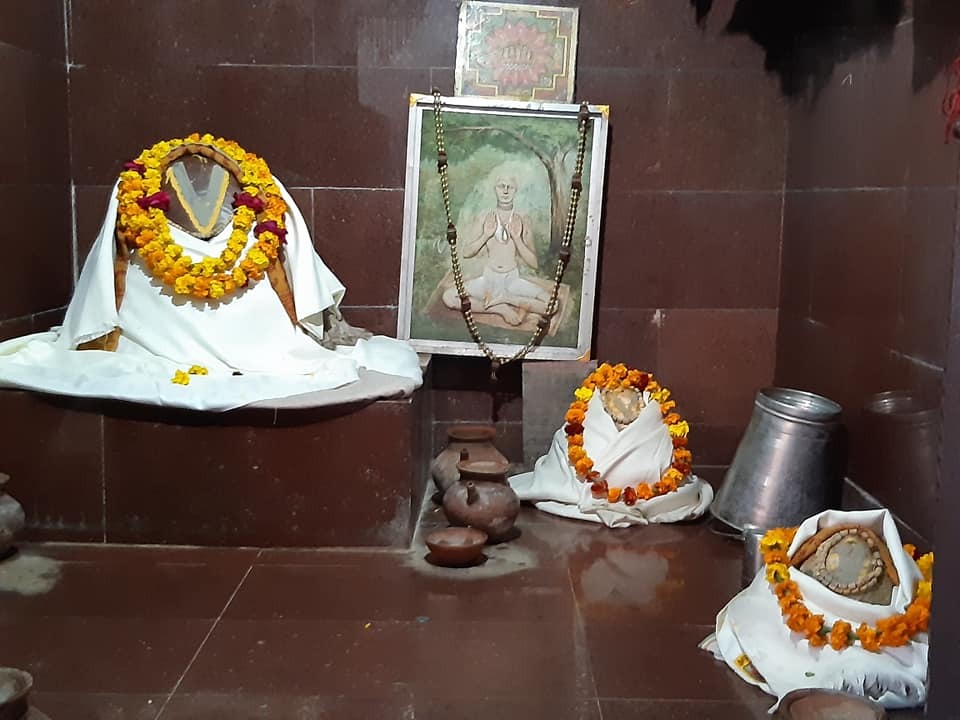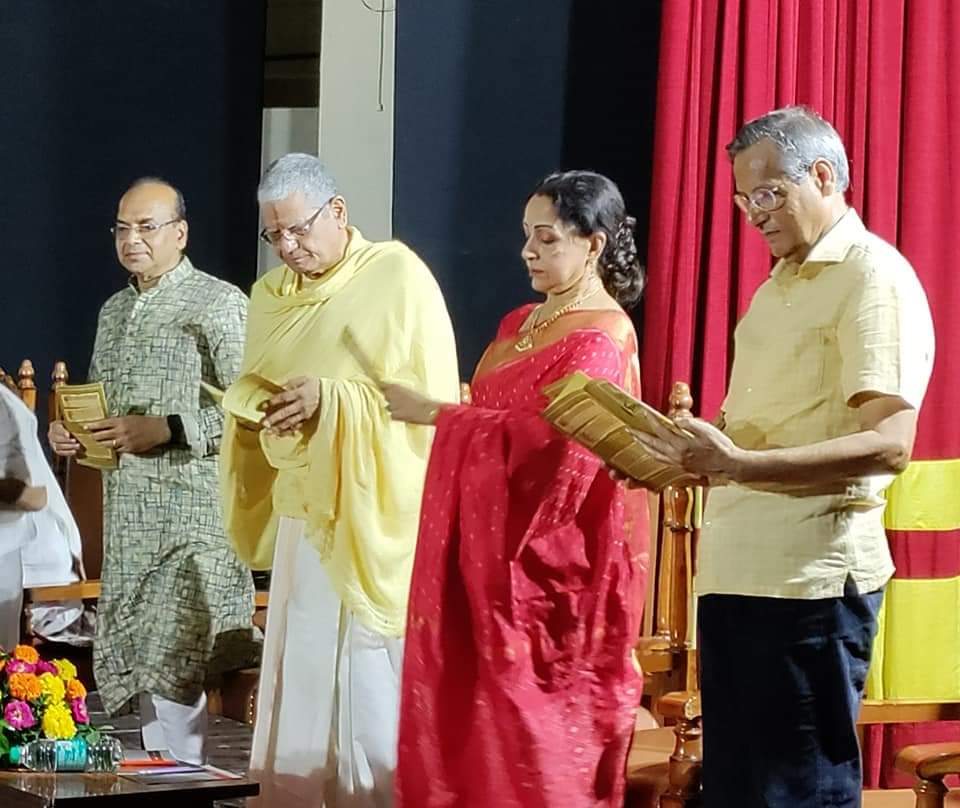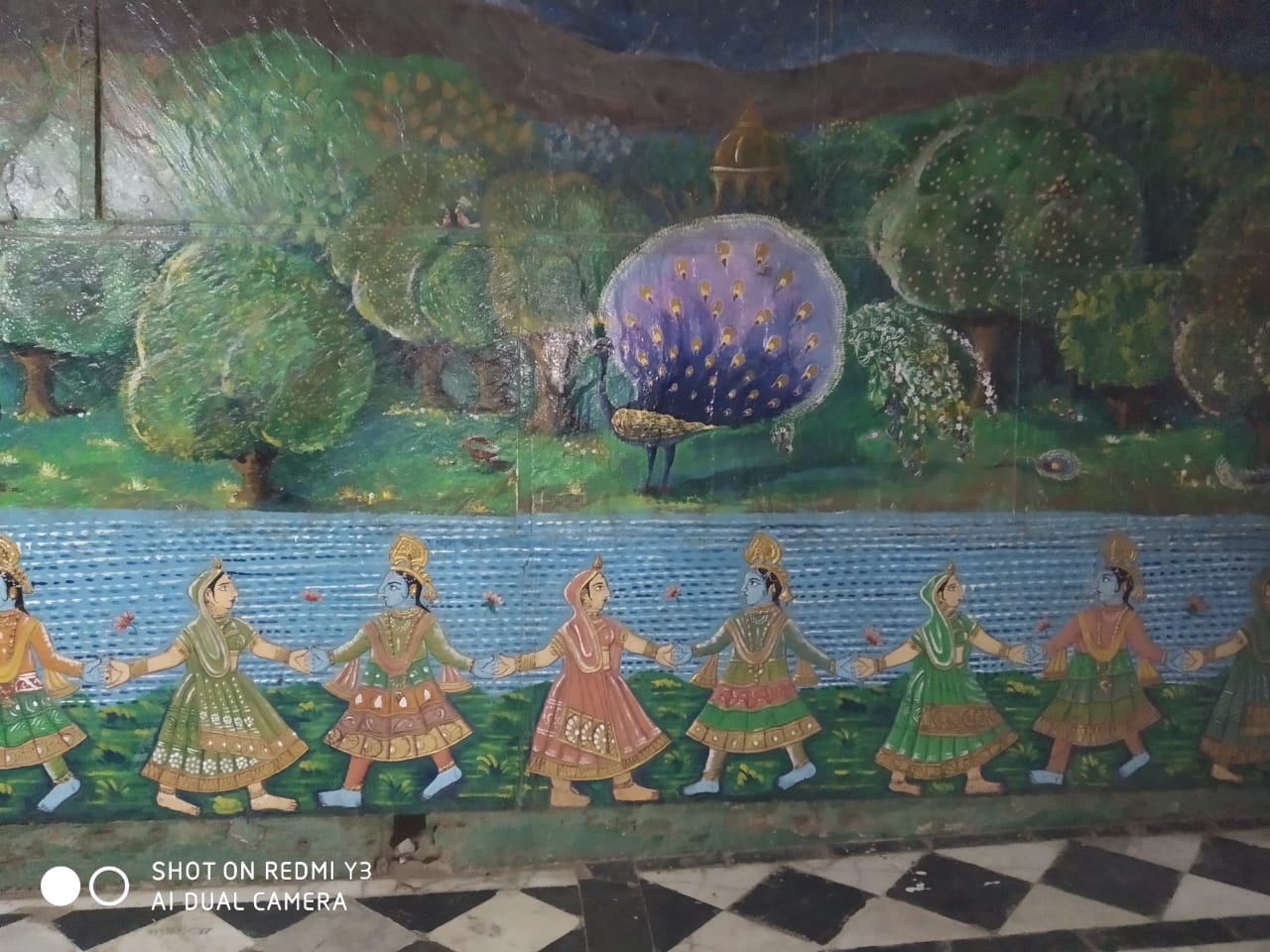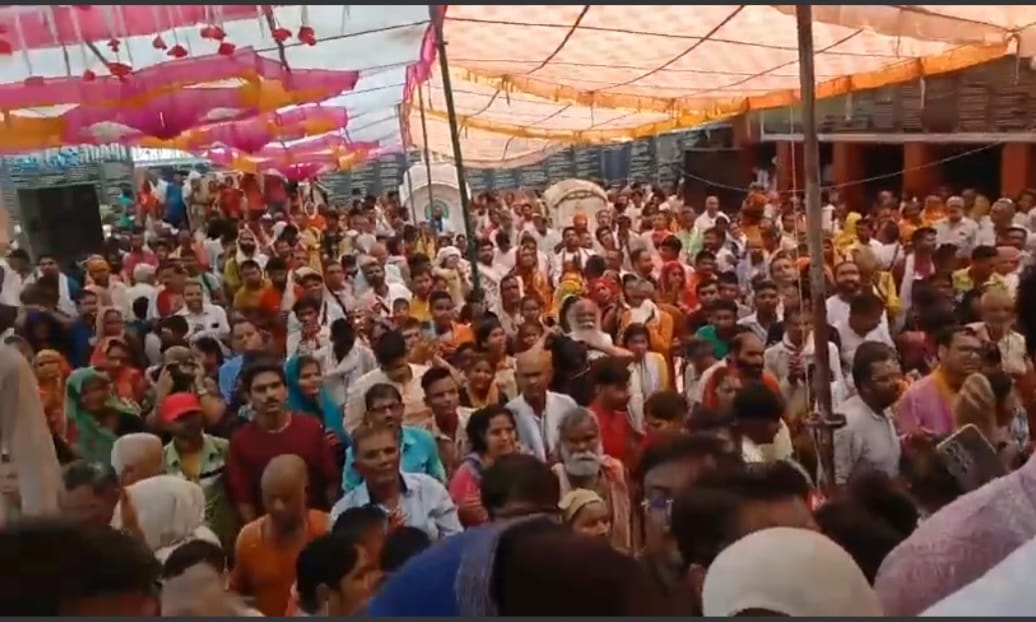- Grand feast is organized on Pausa Amavasya at Ranvari where the villagers from all around participate
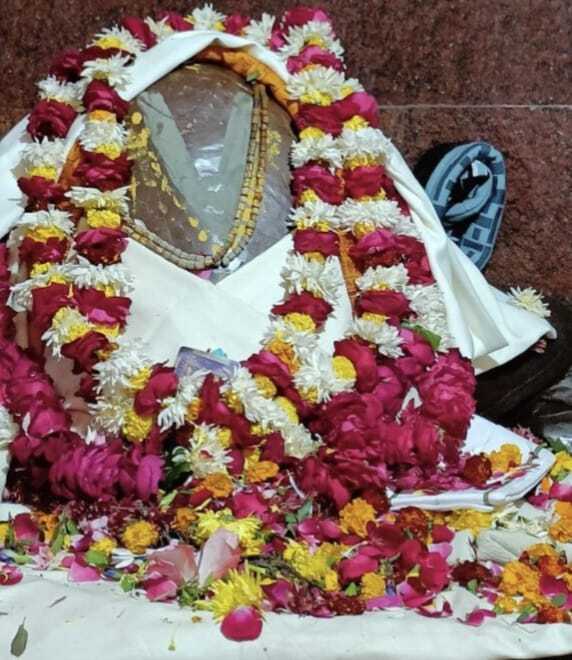
2022.12.24 (Vrindavan Today News): Today is the disappearance day of Siddha Shri Krishnadas Babaji of Ranvari. Every year the villagers of Ranvari invite devotees throughout the entire Vraj Mandal to attain the festival, which takes place on Paushi Amavasya (the new moon day of Paush).
Siddha Baba’s suchak kirtan is sung in the morning in front of his samadhi, followed by a thrilling nagar kirtan through the rustic streets of Ranvari village, and finally a feast of delectable pua-sabji prasad. One can also enjoy a very fulfilling darshan of the many mahatmas who attend the festival.
The Brajwasis firmly believe that whatever one prays for at Siddha Baba’s samadhi, one attains. If you have not had a chance to attend this wonderful celebration, we hope you will also get a chance to go one year and share your heart with siddha baba in prayer.
Until then, here is the story of Siddha Baba as told by Dr. OBL Kapoor in his book The Saints of Vraj, with added details from Shri Haridas Das Babaji’s Gaudiya Vaishnav Jivan. Special thanks are due to Jagdish Dasji who has purchased the rights to Dr. Kapoor’s books and has begun republishing them in updated and annotated form.
Siddha Śrī Kṛṣṇadās Bābājī of Ranvārī
The night Śrī Kṛṣṇadās Bābājī left his body at Ranvārī in a miraculous manner, Siddha Śrī Jagannāth Dās Bābājī and his disciple Bihārī were staying in a cottage nearby. Towards the end of the night, Śrī Jagannāth Dās Bābājī exclaimed, “Bihārī! Go and see what is happening in the cottage of Śrī Kṛṣṇa Dās Bābā!” Bihārī rushed to Kṛṣṇadās Bābā’s cottage. He found that the door of the cottage was latched from inside. Peeping through a small opening in the door he saw that Kṛṣṇadās was sitting crosslegged and his body was ablaze with fire, yet he was coolly chanting Harinam as if nothing had happened. Bihārī went back to Jagannāth Dās Bābā and said, “Bābā! Kṛṣṇadās Bābā’s body is burning.”
Jagannāth Dās Bābā shouted, “Oh! Virahānal, virahānal (the fire of separation)!”
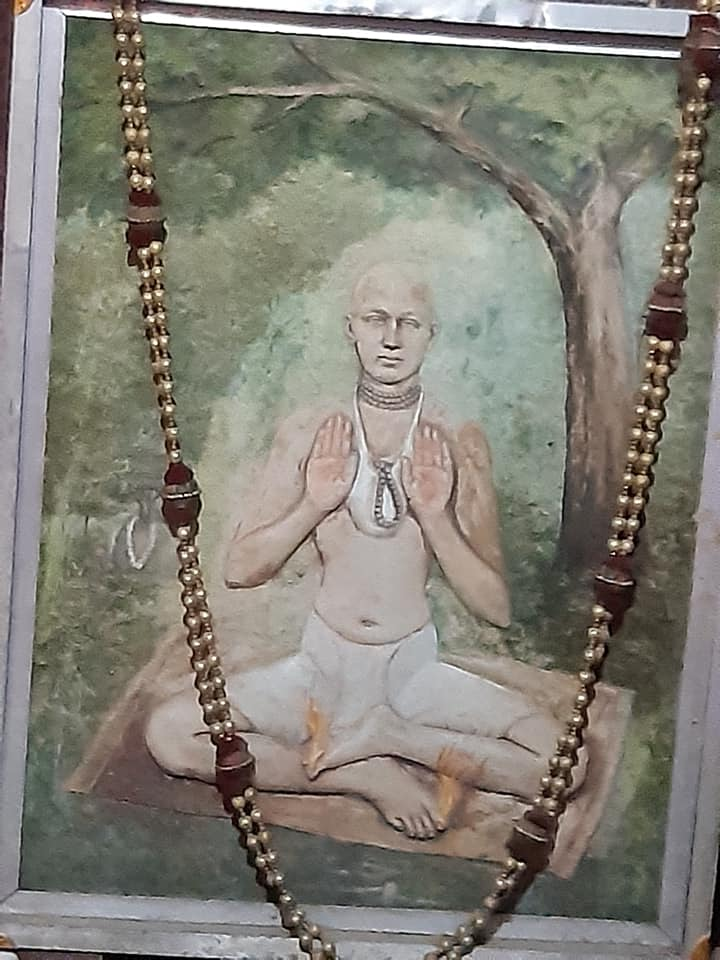
The Vrajavāsīs who lived in the neighborhood came running. They broke open the door of the cottage. They saw that the fire had reached up to the throat of Śrī Kṛṣṇadās Bābā, yet he was chanting Harinām. The Vrajavāsīs kept looking at him with dismay. He raised his two arms, burning like firewood, and said to them, “I bless you that no famine, no epidemic, no calamity will ever befall your village.”[1]
When Jagannāth Dās Bābā saw that the fire had reached up to Śrī Kṛṣṇadās Bābā’s throat, he asked Bihārī for a bit of cotton. Bihārī searched around in the darkened room until he found some. Then Jagannāth Dās Bābā made three wicks out of the cotton and placed them on Bābā’s forehead. The wicks burnt and with them the whole body of Śrī Kṛṣṇadās Bābā was reduced to ashes.
Śrī Kṛṣṇadās Bābā’s earlier name was Śrī Kṛṣṇa Prasād Chaṭṭopadhyay. He was born in Mohammadpur, a village in district Jessore (Yaśohar) in Bengal.[2] His father’s name was Gokulchandra Chattopadhyay. When negotiations regarding his marriage were on, he slipped away from home one night, and walking all the way on foot came to Vṛndāvan. In Vṛndāvan he served Madanmohan jī of Madanmohan Temple for some time and then went to Ranvārī. Ranvārī at that time was one of the thickest forests of Vraj. He built a small kuṭī there and began to live in it. He practised bhajan in the kuṭī throughout the day. In the evening he went to the neighboring village for mādhukari. Since all the Vrajavāsīs of the village revered him as a great saint, each insisted on his accepting some. He got so much mādhukari that all along the way back to his kuṭī he kept on giving it away to the cows, keeping only a small quantity for himself.
Because Bābā had come to Vraj at a very early age, he was not able to go to any other tīrtha (place of pilgrimage). At the age of fifty, he thought that he should once visit the four important tīrthas. Rādhārāṇī then appeared to him in a dream and said: “Coming here, you have surrendered to Me. Do not go anywhere else. Stay in Vrindavan and do bhajan. Here you will attain everything. You have no need of going on pilgrimage.” He explained away the dream and Rādhārāṇī’s advice as the product of his imagination and started on pilgrimage. When he reached Dvārakā he got his body stamped with the tapta-mudrā (heated stamp) of Dvārakā’s temple. But this is not in accordance with the principles of rāgānugā-bhakti of Vraj, although mention is made of it in Hari Bhakti Vilās; the corpus of rituals and religious practices of the Vaiṣṇavas. [Tapta mudra is one of the five elements of initiation for Vaishnavs who focus on Narayan; it is a brand of Narayan’s weapons, the shankh and chakra Ed.]. But after his visit to Dvārakā, his mind became scattered, and he lost all interest in continuing his pilgrimage. Instead of visiting the other three dhāms, he went back to Vraj.
The day Bābā returned to Ranvārī, Rādhārāṇī again appeared to him in a dream at night and said, “Because you have taken the tapta-mudrā from Dvārakā, you are now included in the retinue of Satyabhāmā (wife of Dvārakādhīśa or Kṛṣṇa, the King of Dvārakā). You are no longer fit for Vraja. So go back to Dvārakā!” This time it did not appear to him that the dream was imaginary. The words of Rādhārāṇī struck him like a thunderbolt. He did not know what to do. He went to siddha Kṛṣṇa Dās Bābā of Govardhan for advice. As soon as Kṛṣṇa Dās Bābā saw him, he gave him a warm embrace and said, “Where have you been all these days? Śri Kṛṣṇa Dās replied, “I had gone to Dvārakā. See, I have taken tapta-mudrā.”[3]
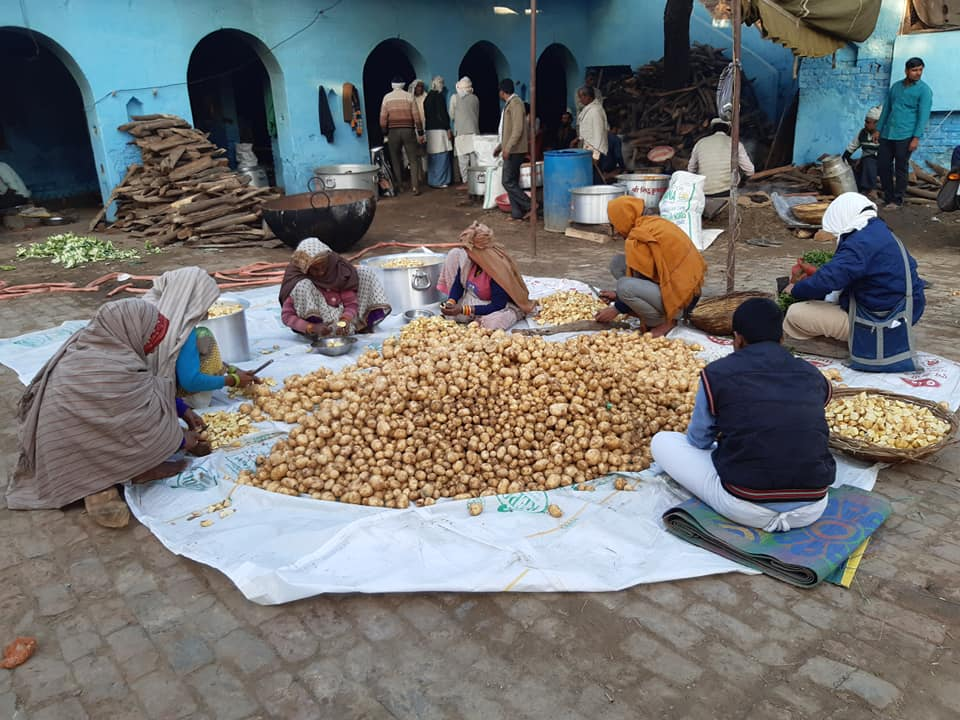
Upon hearing these words, Siddha baba of Govardhan took a step back and let out a great sigh. “Oh! Then from today you are so exalted that I cannot even touch you. You are the sevikā (female attendant) of the most exalted queen of Dvaraka, while I am a dāsī (female servant) of a cowherdess of Vraj. Who am I next to you?” Said Bābā Kṛṣṇadās.
There were at that time a number of other siddha mahātmās in Vraja. Śrī Kṛṣṇa Dās Bābā went to them and sought their advice. They replied, “You have to do as Rādhārāṇī has ordered. How can we say anything against her injunction?” Śrī Kṛṣṇa Dās Bābā returned to Ranvārī disappointed and brokenhearted. He gave up food and drink and confined himself to his kuti. The fire of repentance and separation (viraha) from Rādhārāṇī was continually burning in his heart. Three months passed like this. Then the fire came out. Within three days it reached up to his throat. The fourth day his entire body was reduced to ashes.
Some days after Siddha Baba’s ashes became cool, Bābā’s godbrother Śrī Premdās Bābājī came. He lay prostrate before the ashes of Baba in obeisance and said, “My dear brother! You did not accept wood from my hands? Here, I am now offering you wood.” He placed a log of wood on the pile of his ashes and as soon as he did so, it started to burn.”
Śrī Kṛṣṇa Dās Bābā left his body on Āmāvasya in the month of Pauṣh. Even now on that day the Vrajavāsīs of Ranvārī celebrate his anniversary by organizing a grand festival to which all the vaiṣṇavas of Vraj are invited. Even now, on account of the blessings of Bābā, the village remains free from the onslaught of epidemics and famine.
One might ask why Rādhārāṇī, who is so benign and merciful, became so hard on Sri Krsna Das Baba. Why did she ask him to go and live in Dvārakā, simply because he had taken the tapta-mudra from the temple of Dvārakādhīśa? The answer is that Śrī Kṛṣṇa Dās Bābā was sailing on two boats: rāgānugā bhakti, which is inseparably connected with Vraj, where mādhurya predominates to the extent of eclipsing aisvarya altogether, and ritualistic bhakti of Dvārakā, where madhurya is mixed with aiśvarya. In Vraj, Krsna is a cowherd boy. The peacock feather he wears as his crown and his flute are both the emblems of madhurya. In Dvārakā, Kṛṣṇa is the ruler or governor. The crown he wears and the weapons he wields are the emblems of aisvarya. In Vraj-bhakti, mādhurya mixed with aiśvarya has no place. Radha is not satisfied with bhakti in which aiśvarya has any role to play. She did not refrain from expressing her dissatisfaction even with Kṛṣṇa on meeting him in Kurukṣetra, where he appeared as a king with his entourage and not as a cowherd with his flute (CC Madhya, 1.72-73). Sri Kṛṣṇa Dās Bābā’s attachment with Dvārakā must have proved an obstacle in his attainment of celestial Vrindavan and the holy feet of Rādhā and Kṛṣṇa along with the highest bliss and the richest and most complete spiritual life implied in such attainment. Rādhārāṇī helped him remove the obstacle through the fire of anutāpa (repentance) and viraha (separation).
The villagers preparing for the grand feast on Siddh Baba’s disappearance day
[1] The Gaudiya Vaishnav Jivan adds, “When they heard the news that Baba’s body was burning, the Muslim police inspector and a local Hindu revenue officer came to the scene. It is said that when the Muslim went in front of Siddha Baba, the fire stopped, and when he moved away, it again began to burn. Seeing this, the Hindu officer brought a good amount of ghee and and offered it onto Siddha Baba’s body. Siddha Baba sits [in samadhi] in the same place where his body turned to ash. [Ed.]
[2] Haridās Dāsjī notes that Mohammadpur was, at the time, under the governance of the Bengali Rājā Bīr Sītārām [Ed.]
[3] Tapta-mudrā is a ritual in which the devotee’s arms are branded with heated seals of Lord Nārāyaṇ’s weapons: the conchshell, discus and sometimes others. This rite is one of the five elements of Vaiṣṇava initiation, along with nāma (receiving a new name), mantra, pundra (tilak, the vertical lines drawn in clay on the forehead, unique to one’s particular sect), and yāga (worship of the sacred Image). Tapta mudrā is often renewed yearly by Vaiṣṇavas who follow this practice. However, the Vaiṣṇava traditions of Vraj, who follow the rāgānugā path, do not receive tapta-mudra, but instead mark their bodies with the Holy Name of the Lord in sandalwood paste.


